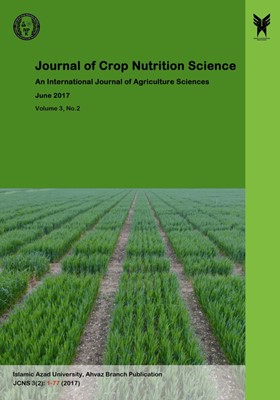Agro-Physiological Traits of Potato (Solanum tuberosum L. cv. Agria) Affected Different Rate of Zeolite and Triple Super Phosphate
محورهای موضوعی : Journal of Crop Nutrition ScienceHamid Madani 1 , Masoud Gomarian 2 , Seid Rasol Mohammadi Hosseini 3
1 - Department of Agronomy, Arak Branch, Islamic Azad University, Arak, Iran.
2 - Department of Agronomy, Arak Branch, Islamic Azad University, Arak, Iran.
3 - Agri-Jahad Organization, Central Province, Arak, Iran.
کلید واژه: phosphorus, Biomass yield, Tuber dry weight,
چکیده مقاله :
The application of zeolite to soils increases cation exchange capacity, and as increases nutrient retention capacity. Imbalanced nutrient management is one of the reasons responsible for low yield of potato in Iran. This study was carried out in research field of Islamic Azad University; Arak Branch at central of Iran to evaluate effect of zeolite particles and phosphorus fertilizer on agro-physiological traits of potato via factorial arrangement based on randomized complete block design with three replications in 2011. The factors included four concentration of zeolite particles (0, 2, 4 and 6 t.ha-1) and three level of triple super phosphate fertilizer (75, 150 and 225 kg.ha-1). Result of analysis of variance indicated effect of different rate of zeolite on all measured traits (instead tuber dry weight) was significant, also chemical phosphorus treatment can affected the mean tuber weight, biomass yield and tuber dry weight significantly. Interaction effect of treatments on mean tuber weight and biomass yield was significant at 5% probability level. The number of stem per plant, mean tuber weight, tuber phosphorus concentration, tuber yield and biomass yield generally improved by increase zeolite rates. Mean of tuber weight, biomass yield and tuber dry weight increased linearly with increasing phosphorus fertilizer rate from 75 to 150 kg.ha-1, the trends of changes in mean of mentioned traits were reduced by high amount of triple super phosphate application (250 kg.ha-1) significantly. Finally according result of this research the highest biomass yield (58 t.ha-1) was achieved by use of 6.0 t.ha-1 zeolite and 150 kg.ha-1 triple super phosphates, therefore, with a lower consumption of phosphate fertilizer (up to 225 kg.ha-1) it can be saved fertilizer without any significant reduction in yield.
Aghaalikhani, M., M. Gholamhoseini, A. Dolatabadian, A. Khodaei-Joghan. and K. S. Asilan. 2012. Zeolite influences on nitrate leaching, nitrogen-use efficiency, yield and yield components of canola in sandy soil. Archiv. Agron. Soil Sci. 58: 1149–1169.
Ahmed, O. H., N. Majid. and N. Muhamad. 2010. Use of zeolite in maize (Zea mays L.) cultivation on nitrogen, potassium, and phosphorus uptake and use efficiency. Intl. J. Physical Sci. 5(15): 2393-2401.
Diaz, R. J. and R. Rosenberg. 2008. Spreading dead zones and consequences for marine ecosystems. Washington Sci. J. 321(5891): 926–929.
Dechassa, N., M. K. Schenk, N. Claassen. and B. Steingrobe. 2003. Phosphorus efficiency of cabbage (Brassica oleraceae L. var. Capitata), carrot (Daucus carota L.), and potato (Solanum tuberosum L.). J. Plant and Soil. 250: 215-224.
Eroglu, N., M. Emekci. and Ch. G. Athana. 2017. Applications of natural zeolites on agriculture and food production. J. Sci. Food Agri. 97(11): 3487–3499.
Ghannad, M., Sh. Ashraf. and Z. T. Alipour. 2014. Combined effects of zeolite, humic acid and potassium sulphate on yield and qualitative characters of potato (Solanum tuberosum L.). Intl. J. Farm Alli. Sci. 3(6): 669-674.
Huang, Z. T. and A. M. Petrovic. 1994. Clinoptilolite zeolite influence on nitrate leaching and nitrogen use efficiency in simulated sand based golf greens. J. Environ. Qual. 23: 1190–1194.
Imas, P. and S. K. Bansal. 1999. Integrated nutrition management in potato. Proc. Symp. Global Potato Meet, Central
Plant. Res. Inst. December. New Delhi.
Khodami Abasiyeh, S., A. H. Shirani Rad, B. Delkhoush, Gh. Noor Mohammadi. and H. Nasrollahi. 2013. Effect of potassium and zeolite on seed, oil and, biological yield in safflower. J. Annals Biol. Res. 4(5): 204-207.
Madani, H., A. Farhadi, A. Pazoki. and M. Changizi. 2009. Effects of different levels of nitrogen and zeolite on traits qualitative and quantitative of potato. J. New Finding Agric. 3(4): 379-391.
Marschner, H. and P. Marschner. 2012. Marcher’s mineral nutrition of higher plants, 3rd Ed. Elsevier Academic Press. London. England.
Ming, D. W. and J. L. Boettinger. 2001. Zeolites in soil environments. In: Bish DL, Ming, D.W, Editors. Natural zeolites: Occurrence, properties, applications. Reviews in mineralogy and geochemistry. Vol. 45. Washington (DC): Mineralogical Society of America and Geochemical Soc. pp: 323–345.
Mumpton, F. 1999. Uses of natural zeolite in agriculture and industry. J. National acad. Sci. 96: 3467-3470.
Murphy, J. and J. P. Riley. 1962. A modified single solution method for the determination of phosphate in natural waters. Anal. Chim. Acta. J. 27: 31-36.
Pickering, H. W., N. W. Menzies. and M. N. Hunter. 2002. Zeolite/phosphate rock a novel slow release phosphorus fertilizer for potted plant production. Sci. Horti. J. 94(3): 333-343.
Plenet, D., A. Mollier. and S. Pellerin, S. 2000. Growth analysis of maize field crops under phosphorus deficiency. Radiation-use efficiency, biomass accumulation and yield components. J. Plant and Soil. 224: 259-272.
Powlson, D. S., A. B. Riche, K. Coleman, M. J. Glendining. and A. P. Whitmore. 2008. Carbon sequestration in European soils through straw incorporation: limitations and alternatives. Waste Management. J. 28: 741-746.
Ramesh, K., D. Damodar Reddy. A. Kumar Biswas. and A. Subba Rao. 2011. Four zeolites and their potential uses in agriculture. Adv. Agron. J. 113(4): 215-236.
Sharmila, B. S. M., P. P. Malarvizi, T. M. Thiyagarajan. and B. Nagendrarao. 2006. Effect of nitrogen, potassium
and magnesium on tuber yield grade and quality of potato. 18th World Cong. Soil Sci. July 9-15. Philadelphia. Pennsylvania. USA.
Zelalem, A., T. Tekalign. and D. Nigussie. 2009. Response of potato (Solanum tuberosum L.) to different rates of nitrogen and phosphorus fertilization on vertisols at Debre Berhan, in the central highlands of Ethiopia. Afr. J. Plant Sci. 3: 16-24.


